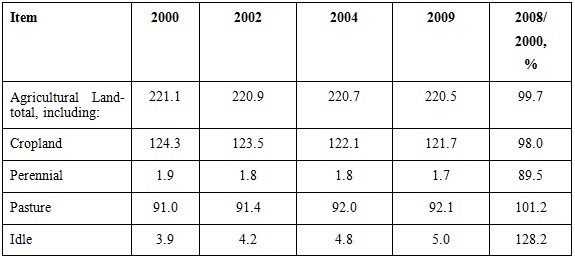1.
INTRODUCTION
Development of Agricultural Land
Market is unique in Russia as compared to other countries. The
abolition of serfdom in 1861 and Stolypin’s Reform as well as
subsequent development of Agricultural Land Market undermined the
communal land system. The super goal of modern Russian Agrarian and
Land Reform is to create the conditions and incentives to provide
sustainable development of agricultural production and to solve the
country's food problem. It should be noted that one of the specific
objectives of the reform is the
redistribution of land from collective to private farming in order
to provide rational use and protection of lands in Russia.
The state’s land
monopoly in Russia was abolished and two main forms of
land ownership: public uses and private farming were introduced.
Land may be converted into individual private property
of citizens for personal use, farming, horticulture, and animal
husbandry as well as to accommodate buildings and constructions for
individual enterprise, to build and maintain dwelling houses,
country cottages, garages.
The private property may be
established also as the result of the conversion of lands belonged
to former collective and state farms as well as joint-stock
companies including those established on the
basis of state farms and other state-owned enterprises, and lands
granted for collective horticultural production, animal
husbandry, and collective country-house construction.
The principle of independent
agricultural production by land proprietors, landowners, and tenants
has been secured. Any interference in their activity by state,
economic or other bodies is prohibited. The economic, social, and
legal basis for the organization and activity of private farms and
coops on the territory of Russia has been determined. The rights of
citizens to organize private farms, economic independence,
assistance, state protection of their legitimate interests and the
right to free cooperation have been guaranteed.
It is proclaimed that a
private farm should be an independent economic entity having the
rights of a legal subject, which produces, processes, and sells
agricultural products. Parcels of land may be leased by local
authorities or citizens who are land proprietors. This was the first
time in Russia of a right is available to divide and reform
collective and state farmland into shares.
Member of former collective
farm or state farm has the right to withdraw and start up a
farmstead of his own without asking for
consent of collective or the management. Upon decision by local
authorities, such a farmstead is granted a piece of land of a size
corresponding to the farmstead member’s share in the land stock or
value.
A withdrawing
farmer may expand his land possessions by purchase. During the
reorganization of collective and state farms, these farms were
broken up into smaller units and their juridical status was made
consistent with legislation of the Russian Federation.
2. LAND TENURE
The Russian
Federation’s territory was amounted 1,709.8 million hectares in
2009. The most important piece of the area is agricultural
land. The total agricultural land area was estimated 400.0 million
hectares in 2009 or 23.4 % of the total Russian Federation area (see
Table 1).
The cropland,
perennial, pastures, hay field lands as well as idle land were
amounted 196.1 million hectares or 49.0 % of total agricultural land
area in 2009 (see Table 2).
Table 2. Agricultural Land, Russian
Federation, 2009, million hectares
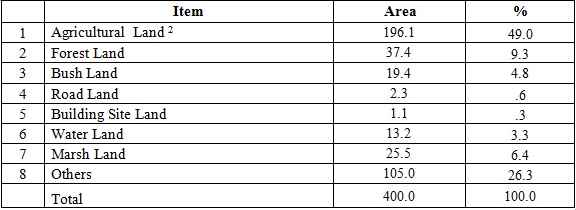
Source: Rosnedvizhimost’, 2010.
Includes: cropland, perennial, pasture, hay field land as
well as idle land.
Source: Russian National Economy Fact Book 2008 (Rossija v tsifrakh,
2008) Moscow, Federal Service of State Statistics, 2008, p.238.
3. LEGAL FRAMEWORK
The legal framework for Land Market must be also improved. There are
some contradictions between basic legal acts (the Constitution of
the Russian Federation, the Civil Code, the Land Code, The Federal
Mortgage Act, the Agricultural Land Market Act, the Federal State
Registration of the Rights to Real Estate Act, and etc.) related to
regulation of Agricultural Land Market. Due to it, despite of
adoption the Land Code as well as the Agricultural Land Market Act
the legal basis for implementation of Agricultural Land Market is
still unclear.
Both the Russian Constitution, adopted in 1993, and the Civil Code,
adopted in 1994, upholds the right to own private property, which
includes both land plots and buildings. Despite these guarantees,
however, land reform was for a long time the subject of national
political debate. The general principles of land ownership are set
out in the Constitution. Article 9 of the Constitution establishes
the principle of private ownership of land. However, it does not
provide any procedure for the transfer of land, historically owned
by the state, into private ownership.
The Land Code approved by the State Duma in 2001 has limited
applicability to some categories of land, which are the subject of
the separate federal laws. Such land includes water, forestland as
well as agricultural land. According to the Land Code, the
Agricultural Land Market Act governs the agricultural land market
transactions. Thus, in fact, the Land Code applies only to
non-agricultural land, which covers about just two percents of the
total Russian land area.
In accordance with the Agricultural Land Market Act, the Federal
Mortgage Act governs the agricultural land mortgage transactions.
The Farm Credit System as well as Agricultural Land Mortgage Bank
must be introduced to provide an access for farmers to agricultural
credit and to guarantee them the right to use their land as well as
other real estate as collateral.
Thus, the Russian Land and Real Estate legislation must be revised
to eliminate the substantial contradictions existing between
different laws now. Due to it some substantial changes have been
made in Agricultural Land Market Act as well as the Federal Land Use
Planning Act on July 18, 2005 by the State Duma. According to them
land shares belonged to former collective and state farmers must be
demarcated on the ground as well as their location must be
determined. In our opinion it will positively affect on development
of Agricultural Land Market in the Russian Federation. But the
legislation must be amended to enable Land Market and ensure clear
delineation of the corresponding property rights among the various
level of the government. In 2001 the Federal Separation The State
Ownership On Land Act ( Zakon o razgranichenii gosudarstvennoy
sobstvennosti na zemlyou) was adopted by the State Duma. According
to the Agricultural Land Market Act the Regional Agricultural Land
Markets Acts were introduced at the regional level.
In accordance with article 8 of the Land Code The Land
Transformation Act (Zakon o perevode zemel i zemelnykh uchastkov iz
odnoy kategorii v druguyou) has been adopted on December 21, 2004.
According to the Law the land transformation procedure has been
introduced and clarified. According to the Law the Forest Code as
well as Federal Ecological Expertise Act has been changed. On
January 1, 2006 the Land Taxation Act was abolished and new chapter
# 31 of the Russian Tax Code “Land Taxation” was introduced.
According to the chapter the Land Taxation is exclusive
responsibility of local governments.
In that sense it’s very important to make cadastre information more
understandable and transparent for customers. It must be pointed out
that so called ”cadastral value” of agricultural land using in
Russia is not applicable for Agricultural Land Taxation as well as
Agricultural Land Market because there is no relation to market land
value. As a result, Russian banks have not accepted “cadastral
value” as a basis for Agricultural Land Mortgage transactions (see
Table 5).Because of it, outside investors as well as other customers
are not being able to get reliable information about the value of
agricultural land plots and participate as educated and
well-informed market agents (buyers or sellers) in Agricultural Land
Market transactions.
Despite of it, a new Land Taxation System based on so called
“cadastral value “was adopted by the Russian Parliament in November,
2004. According to it the maximum Agricultural Land Tax Rate defines
as 0.3% of “cadastral value” of agricultural land. But a new
Cadastre Value Methodology based on Market Economy principles has
been developed.
On July 24, 2007 the State Real Estate Cadastre Act (Zakon o
gosudarstvennom kadastre nedvizhimosti) was issued. According to the
Law the State Real Estate Cadastre was introduced on March 1, 2008.
The Law governs the Real Estate Cadastre Survey Activities as well
as collection, processing and usage of Real Estate Cadastre
Information. In accordance with p.2 of article 1 of the Law the
State Real Estate Cadastre is a registered record that shows the
ownership, boundaries, and values of land and buildings. Such
register shows the owner of each parcel of land, its area, its use
and category, buildings as well as their fiscal assessment. In
accordance with p.5 of article 1 of the Law the land plots,
buildings and other property are the subjects of the Real Estate
Cadastral Survey.
The Agricultural Land Market Act as well as some other land acts was
amended on December 29, 2010 by the special federal law #435. The
order of compulsory withdrawal of sites of agricultural appointment
was settled. According to the Law it’s possible through court in a
case when the land isn't used 3 years and more, and also at
essential decrease in fertility or considerable deterioration of
ecological conditions. Signs of non-use and criteria of decrease in
fertility (ecology deterioration) will be defined by the Government
of the Russian Federation. Administrative responsibility for non-use
of the agricultural lands to destination is strengthened. A number
of amendments is directed on perfection of a turn of the land shares
received at privatization of agricultural lands. So, the transfer
order (without tendering) municipal sites in the property or rent to
the agricultural organizations and farmers, their using is
simplified. The price of such land can't exceed 15 %, and a rent -
.3 % of its cadastral value. Features of formation of sites from the
lands of agricultural appointment, fulfillment of transactions with
land shares are established. The order of the termination of the
rights to unclaimed land shares is settled. As those of what the
proprietor hasn't disposed within 3 years (except those, in
particular, are considered, the rights on which are registered).
Possibility of disclaimer of the property on a land share is
provided. The law comes into force since July, 1st, 2011, except for
separate positions for which other terms of conducting in action are
provided.
4. INSTITUTIONAL FRAMEWORK
The main objective of the Russian Government policy in the area of
Real Estate is to create conditions for efficient use and
development of Real Estate Market meeting the requirements of
society and individual citizens.
On December 25, 2008 in accordance with the President of the Russian
Federation Decree on Federal Service of State Registration, Cadastre
and Mapping the Federal Service of Real Estate Cadastre as well as
Federal Agency of Geodesy and Mapping were dissolved. According to
the Decree the Federal Registration Service was renamed into Federal
Service on State Registration, Cadastre and Mapping (Rosreestr). The
functions of mentioned above agencies were transferred to Rosreestr.
The Federal Service on State Registration, Cadastre and Mapping is
now under authority of Ministry of Economic Development
(Ministerstvo ekonomicheskogo razvitiya) of the Russian Federation.
At regional level local offices of former Federal Service of Real
Estate Cadastre as well as Land Cadastre Chambers have been
transferred to Federal Service on State Registration, Cadastre and
Mapping.
5. REGIONAL LAND POLICIES
Development of Agricultural Land Market in the Russian Federation is
mostly depended on Regional Land Policies. One of the successful
examples is Orel Region Land Policy which based on legal framework
included the Federal Legislation as well as local regulations.
Orel Oblast Land Legislation is based on the following acts: Decree
of the Head of Administration of Orel Oblast # 616 issued on
December 12, 1997 on farm reorganization and land privatization and
Target Program on development of the Legal Basis of Orel Oblast Land
Reform approved by the regional authorities on October 10, 1998. The
Land Policy is the main part of Orel Regional Government
Agricultural Policy included the following components: farm
reorganization and land privatization, horizontal and vertical
cooperation as well as integration of agricultural producers,
development of innovation and investment activities in agriculture,
development of Regional Agricultural Land Market.
Orel region agricultural land was amounted 2,103.1 thousand hectares
or 85.3 % of total regional land in 2009 (see Table 8). Break down
of Orel Oblast Land is displayed in Table 9.
Table 8. Orel Oblast Land, 2008-2009
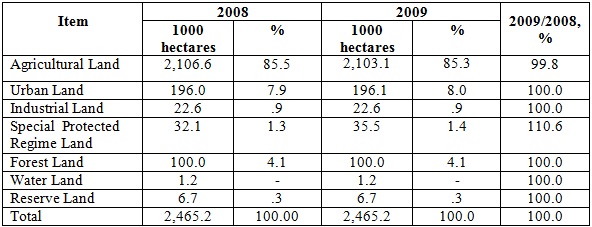
Source: Orelnedvizhimost’, 2010.
Table 9. Break down of Orel Oblast Land, 2009,
1000 hectares

Source: Orelnedvizhimost’, 2010.
The private land ownership plays the dominant role in the
regional agriculture and consists mostly of land shares belonged to
former collective and state farmers (see Table 10).
Table 10. Land Tenure, Orel Oblast, 2009, 1000
hectares
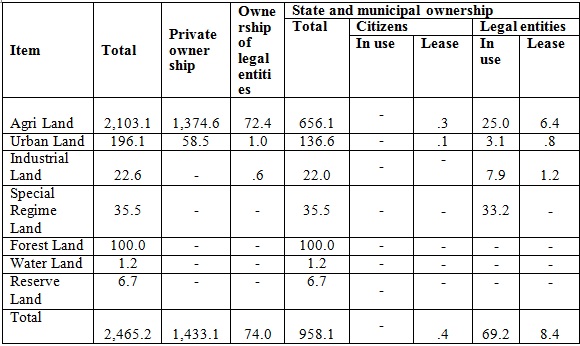
Source: Orelnedvizhimost’, 2010.
Main role in Orel Oblast Agricultural Land Tenure
play joint stock companies and partnerships or parastatals (see
Table 11). They occupied 1,264.2 (82.0 %) thousand hectares of the
regional agricultural land in 2009. They have also rented the most
of agricultural land shares.
Table 11. Agricultural Land Tenure, Orel
Oblast, 2009, 1000 hectars

Source: Orelnedvizhimost’, 2010.
In 2010 there were 1,247 private farms in the region. The average
size of the farm was amounted 142.3 hectares. (See Table 12).
Table 12. Private Agricultural Land Ownership,
Orel Oblast, 1990-2009
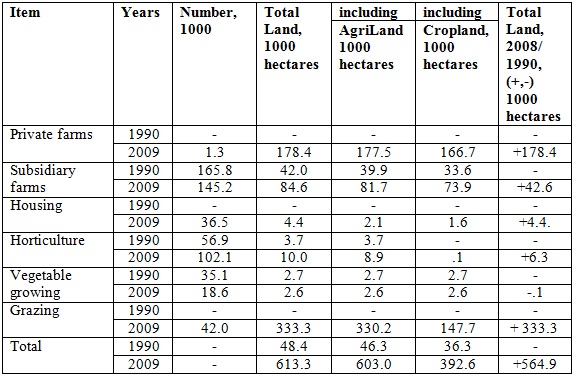
Source: Orelnedvizhimost’, 2010.
One of the most important problems of Agricultural Land Market
Development is to create legal as well as institutional framework
for Agricultural Land Mortgage Transactions. In accordance with the
target program “Development of Land Reform in Orel Region for
1999-2002” a new approach for development of Agricultural Land
Mortgage has been introduced. According to the program private farms
as well as other agricultural producers have an opportunity to use
agricultural land as collateral to get loans. According to the
program Agricultural Land Mortgage Obligations should be issued to
develop and stimulate Agricultural Land Market in the region too.
According to 2003 Orel Oblast Agricultural Land Market Act the
regional land market company “Orel Land Investment Company” has been
established. The company operates as an open joint stock
company. In accordance with Orel Regional Government Order # 108
issued on July 22, 2003 the super goal the company is creating of
favorable environment for development of Agricultural Land Market in
Orel Region
Now it’s very important to launch the public
relation campaign focused on Agricultural Land Market Development to
strengthen people’s ability to understand the role and importance of
Agricultural Land Market transactions. Due to it the company
publishes newspaper “Orlovskie zemelnie vedomosti” (Orel Land News)
which provides public access to agricultural land market
transactions as well as agricultural land prices
information.According to article 2 of 2003 Orel Oblast Agricultural
Land Market Act, all agricultural land market transactions must be
executed via Orel Land Investment Company. As a result Orel Oblast
Government Land Policy the efficiency of agricultural production as
well as a number of agricultural land transactions has been
increased in the region (see Table 13).
Table 13. Land Market Transactions, Orel Region, 2009
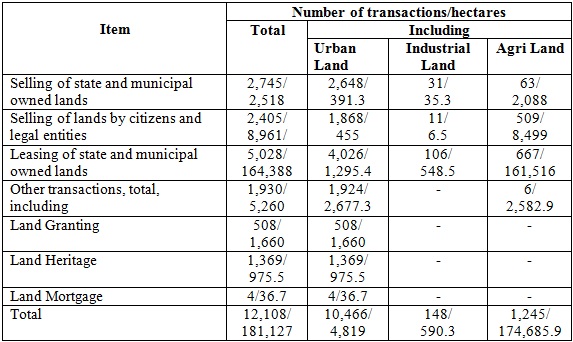
Source: Orelnedvizhimost’, 2010.
As we mentioned before the main role in the regional Agricultural
Land Tenure have played land shares. Most of land share owners have
been officially registered by local authorities. The agricultural
land has been consolidated by purchase or rent of property rights on
land shares belonged to former collective or state farmers by
private farms, parastatals and agricultural holding corporations.
However, agricultural holding corporations have played the dominant
role in this process. In Orel region the agricultural holding
corporations mostly just rent land shares belonged to former
collective or state farmers to expand production scale and increase
regional agricultural production efficiency. In that case the land
shares owners keep their property rights.
However, Agricultural Land Mortgage System has not developed yet
both on the federal and the regional level. For example there were
just four Land Mortgage Transaction in Orel Region in 2009 (36.7
hectares).In this sense it’s very important to determine
Agricultural Land Mortgage Value based on Agricultural Land Market
Value. Orel Region Districts Agricultural Land Mortgage Values
calculated on the basis of Land Market Auction Price Model are
displayed in Table 14. The Land Market Auction Price Model looks
like:
Va=[
R0(1+g)(1-t)]/{[k(1-at)-g] (1+c)+p(1-t)};
(1)
Where:
Va
-Land Market Auction Price, rubles per hectare;
R0 -Land Rent, rubles per hectare;
g - Land Rent Growth, %;
t - Income Tax, %;
p - Land Tax, %;
k - Interest Rate, %;
c - Transaction Costs;
a - Tax Adjustment Coefficient, calculated as a=R0
(1+g)/ [ R0(1+g) +V1-V0)].
V0 - Cadastral Value of Agricultural Land, rubles per
hectare;
V1 - Cadastral Value of Agricultural Land adjusted for
Land Rent Growth, rubles per hectare.
Land Rent value (R0) was calculated on the base of
cadastral value of agricultural land treated as V0
and official interest rate (3%) used for determination of the value.
Land Rent Growth was estimated 10%.Transaction costs are estimated
as 10% too. Income Tax was taken as official income tax rate
estimated as 20 %.Land Tax was
estimated according to official land tax rate 0.3 % of cadastral
land value. Interest Rate was taken as 15 %.
In general, we can treat the Land Market Auction Price as a ratio
between Land Rent and Interest Rate adjusted for income as well as
land taxation. The ratio between Agricultural Land Market Auction
Price and Agricultural Land Mortgage Value was taken as 70 %. In our
opinion the value should be accepted both the commercial banks and
the agricultural producers.
Table 14. Agricultural Land Mortgage Values, Orel Oblast, 2009

6. CONCLUSION
The following measures must be implemented to strengthen the
organizational as well as institutional sustainability of
Agricultural Land Market in the Russian Federation:
-
Agricultural Land Market Legislation must be revised and amended
both on the federal as well as the regional level.
-
The institutional framework for implementation of Agricultural
Land Market must be improved both on the federal as well as the
regional level too.
-
Agricultural Land Auctions must be introduced to stimulate
development of Agricultural Land Market in the regions of the
Russian Federation.
-
The training and retraining programs related to Agricultural
Land Market issues must be introduced.
-
Real Estate Cadastre Management should be improved in accordance
with market economy standards.
-
The public relation campaign to strengthen people’s ability to
understand the role and importance of Agricultural Land Market
Development must be initiated.
-
Orel Regional Land Policy or Orel Model is one of successful
ways of development of Agricultural Land Market in the Russian
Federation.
-
Orel Oblast Agricultural Land Reform experience should be
scrutinized and replicated in other Russian regions.
REFERENCES
-
Russian National Economy Fact Book 2008 (Rossija v tsifrakh,
2008) Moscow, Federal Service of State Statistics.
-
Russian National Report on Land, Rosnedvizhimost, 2010
-
Orel Oblast Report on Land, Orelnedvizhimost, 2010
BIOGRAPHICAL NOTES
Alexander Sagaydak
D.Sc, Professor of Economics,
Director of Department of Agricultural Economics and Farm
Management,
State University of Land Use Planning, Moscow, Russia
Anna Lukyanchikova
PhD, Assistant Professor of Department of Agricultural Economics and
Farm Management,
State University of Land Use Planning, Moscow, Russia
CONTACTS
State University of Land Use Planning,
15 Kazakova Str., Moscow, 105064, Russia
Tel. +7-499-261-6143
Fax. +7-499- 261-9545
Email: asagaydak@yahoo.com
Web site: www.guz.ru


